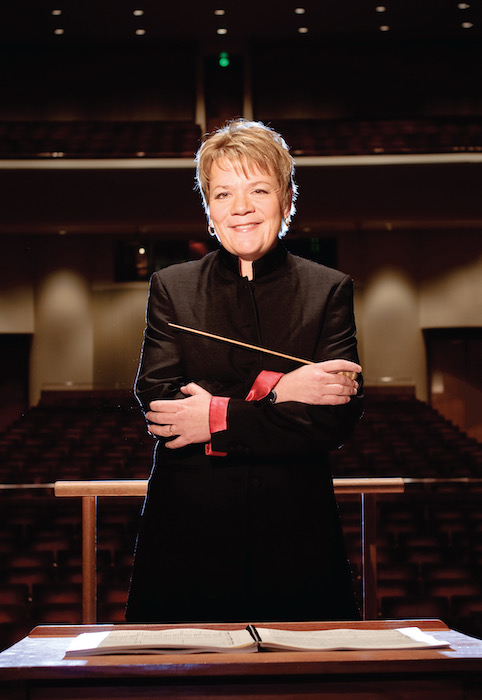Alsop, Baltimore Symphony overcome distractions to tackle epic Messiaen

Marin Alsop conducted the Baltimore Symphony Orchestra in Messiaen’s “Turangalîla-Symphonie” Thursday night at Meyerhoff Symphony Hall.
When an orchestra performs Messiaen’s colossal Turangalîla-Symphonie for the first time in its history, it should be a moment of celebration. Marin Alsop and the Baltimore Symphony Orchestra finally tackled the work Thursday night at Meyerhoff Symphony Hall, at a time of multiple tensions for the ensemble. Their rendition of this jubilant, crazy work was technically assured, yet at the same time too cautious to create that needed air of cosmic plenitude.
Alsop was careful especially with balances, often holding back the full strings or the crashing brass and percussion. On one hand, this made the work’s major’s climaxes, especially at the end of the fifth and tenth movements, stand out; still, even those seemed tame. Her tempo choices, too, were quick and often business-like, seeming to rush slightly through so many movements marked “Modéré.” The combination robbed the work of its essential sonic excess, especially in the understated playing of the brass on the menacing “Statue” theme, inspired by Aztec skull racks.
This approach did allow the playing of the work’s two soloists to emerge. Pianist Jean-Yves Thibaudet played with exceptional flair, jabbing and walloping with great force in the more pointed episodes. The most gorgeous moment, however, came as he launched echoing bird calls over the lush strings in the “Jardin du sommeil d’Amour” movement, answered by the distant twittering of woodwind solos. Thibaudet was shadowed brilliantly by the BSO’s outstanding keyboard player, Lura Johnson, on the daunting celesta part.
Nathalie Forget, who teaches the ondes martenot at the Conservatoire National Supérieur de Paris, favored subtlety in her performance. Electronic buzzes mysteriously nestled up against the clarinet solos, for example, in the “Développement d’amour” movement.
Messiaen included the ondes martenot, an electronic instrument created only a couple decades before the work’s premiere in 1949, as an otherworldly sound. Its swooping glissando sighs and ecstatic shrieks can capture something exclamatory, even orgasmic in the score. Forget played the instrument at lower volume levels, so that her sound lay just under that of the resplendent strings on the melody of the love theme in the “Chant d’amour” movements. With a little more space in the pacing, Alsop could have helped all of these moments luxuriate more.
Alsop’s strength came in the more rhythmically driving movements, especially the crucial “Joie du sang des étoiles,” a moment where the passionate embrace of the lovers transcends life and death, opening out into the universe itself. Here and in the often threatening “Turangalîla” movements, Alsop’s gestures and dancing movements on the podium elicited manic energy from the orchestra. The percussion section gave precision and variety to the gamelan-like passages in the second and third of those “Turangalîla” movements. Recent controversies seem to have unsettled the BSO string section, which was lacking its normal cohesion and polish, including in the critical passages for small string ensemble.
In the best possible way, Alsop opened the floodgates for this monumental symphony’s “Finale,” an ebullient conclusion in which the whole orchestra seemed to let go of its inhibitions. For those few minutes at least, everyone on stage sounded focused squarely on the music.
The program will be repeated 3 p.m. Sunday at Strathmore.bsomusic.org; 877-BSO-1444
